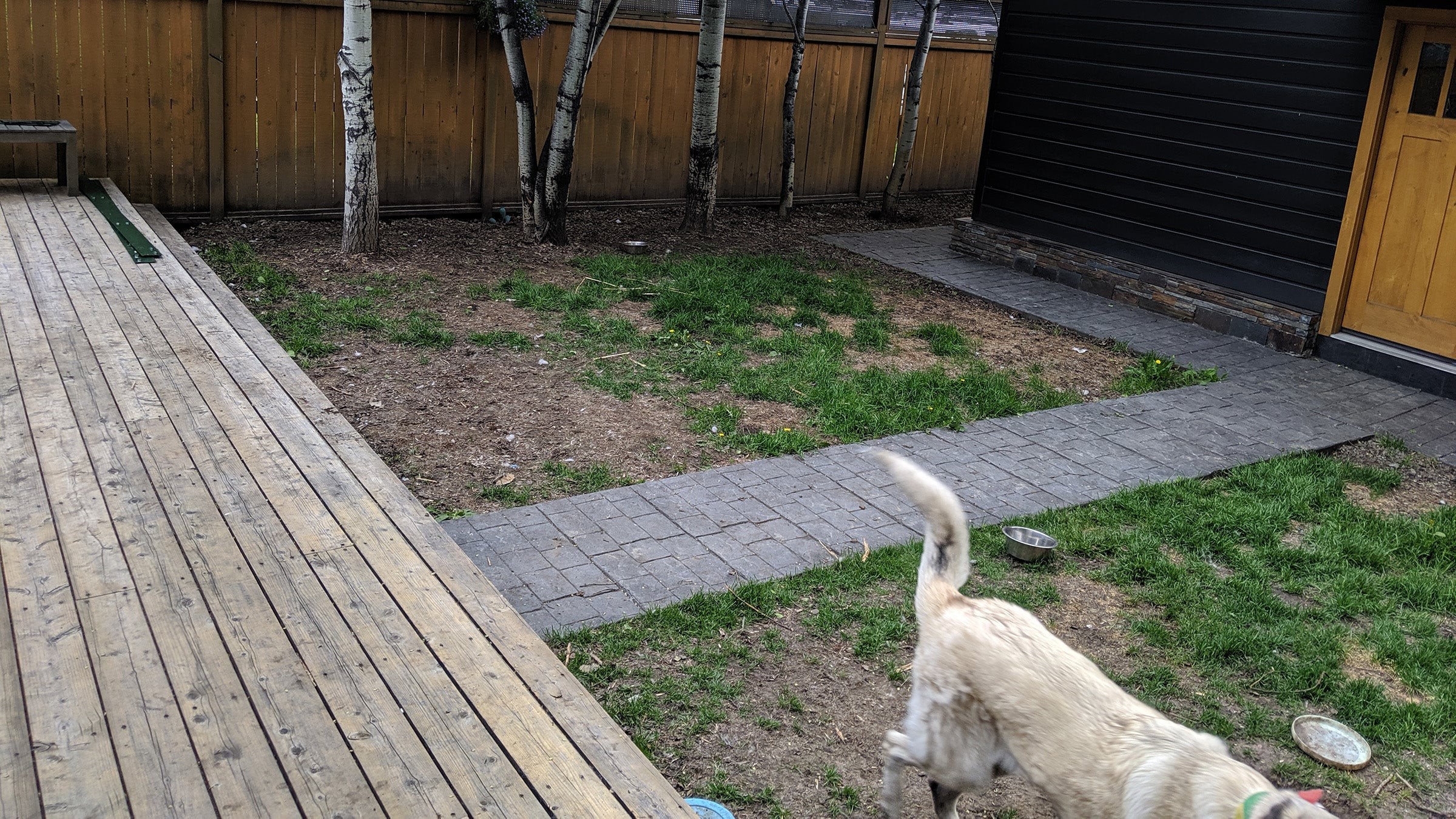Three years ago, facing a backyard ravaged by my three large dogs, I decided to replace our natural grass with artificial turf. The initial cost was significant, but the transformation has been nothing short of remarkable. Even with the daily activities of Wiley, Bowie, and Teddy, our yard remains pristine, mirroring the day it was installed. For dog owners seeking a home upgrade that truly simplifies pet parenting, artificial turf stands out as the best investment I’ve made.
Our once lush, green backyard succumbed to the energetic paws of our dogs within a single year. If it weren’t for Montana’s lengthy snow-covered winters, the destruction might have been even quicker. This wasn’t merely an aesthetic issue; the dirt and mud became constant companions, clinging to their fur and paws, and subsequently, our clean interiors. With three large dogs already demanding considerable attention—think shedding, exercise, and the occasional mischief—the added chore of frequent mopping felt overwhelming.
Image: Before artificial turf installation, the backyard was a muddy and unpleasant space due to dog activity.
Adding to the problem, the exposed soil hardened into a crust during dry spells, trapping urine and lingering fecal matter that I couldn’t completely remove. On warmer days, the backyard emitted a foul odor, making our deck practically unusable.
Of course, the dogs weren’t to blame. They simply wanted to play, run, and relieve themselves in their own yard, as they should. The convenience of letting them out without the need for leashes and walks was precisely why we valued having a yard.
Exploring alternatives, artificial turf emerged as the most practical solution. Xeriscaping didn’t align with the natural Montana ecosystem, and I anticipated the dogs would scatter rocks, uproot plants, and dig incessantly. Replacing grass with gravel seemed visually unappealing, and paving the yard, even with attractive stones, didn’t resonate with us.
While DIY artificial turf installation crossed my mind, I soon realized it was more complex than simply rolling out synthetic grass. It involved excavating the yard to a depth of 12 inches and layering gravel and sand. Our sprinkler system needed adjustments, requiring professional expertise. Concerned about my DIY skills and the expense of tool rentals, professional installation appeared to be the wiser, hassle-free choice.
Finding an installer in Montana was straightforward—JW Synthetic Grass. Josef, the owner, provided a consultation and showcased various product samples. Although all synthetic turfs are permeable, those designed for dogs feature larger gaps in the backing. This facilitates efficient drainage of urine and even small solid waste particles. Examining the samples, I observed how the woven backing securely held the polyethylene tufts forming the synthetic grass blades. Josef assured me of its near indestructibility, cautioning only against intense heat sources, and offered a 20-year warranty. He also recommended a deodorizing sand specifically for dog urine, designed to minimize lingering odors from any liquids accumulating beneath the turf.
The project cost approximately $7.50 per square foot, encompassing both labor and materials. This rate would be more economical for larger yards. We opted for a higher-end synthetic grass known for its longer, softer, and more natural appearance. A team of five completed the installation within two afternoons.
Image: Backyard transformed with pet-friendly artificial turf, providing a clean and usable outdoor space for dogs and owners.
Three years later, despite countless pees, poops, claws, teeth, and diverse weather conditions, our artificial lawn looks as good as new. Muddy paw prints are a thing of the past. My backyard maintenance time has drastically reduced to perhaps half a day annually. It enhances our home’s aesthetics, especially when the snow recedes enough to appreciate it. In short, my wife and I are extremely satisfied with our investment.
Living with Artificial Turf and Dogs: Answering Common Questions
Having received numerous inquiries from fellow dog owners, I’m sharing insights into the realities of living with a synthetic lawn, addressing common concerns below.
1. Can Dogs Damage Artificial Turf?
The polyethylene grass fibers are incredibly resilient. Dogs cannot harm it through running or even chewing. The turf sheets are firmly anchored into the substrate with substantial nails. While a determined dog might manage to lift a corner, as one of ours did, leading to a small hole in the sand underneath, fixing it was simple—refilling the hole and re-securing the nail. They haven’t bothered with it since.
2. What is the Maintenance Like for Artificial Turf with Pets?
Daily, I remove solid waste. Feeding our dogs a diet of raw meat, organs, eggs, and bones results in significantly less stool volume compared to kibble-fed dogs. The waste is also firm and less odorous. Any residual crumbs are naturally washed away by rain or a garden hose. During winter, some waste may accumulate, and with three large dogs, spring thaw can reveal a less-than-pleasant yard. Once the snow melts sufficiently, I manually remove any leftover waste, thoroughly rake the yard to eliminate debris, and then pressure wash it using a 15-degree nozzle. Raking helps fluff the blades, and pressure washing ensures cleanliness. Typically, a full pressure wash is needed only once a year, with occasional spot cleaning for diarrhea. In summer, I apply Simple Green Turf Deodorizer every couple of weeks, especially before gatherings. Autumn leaf raking is the only additional maintenance.
3. Does Artificial Turf Get Hot for Dogs?
Our 650-square-foot backyard faces south, enclosed by the house and a black garage. It receives direct sunlight for most of the day, with limited shade. On days exceeding 90 degrees Fahrenheit, the turf does become warm to the touch, and the dogs avoid lying in direct sun. However, it doesn’t retain excessive heat to make the space unusable. Some owners opt to lightly sprinkle their artificial lawns with water on extremely hot days.
4. Is Artificial Turf Comfortable to Walk on Barefoot?
The cleanliness of artificial turf is controllable. As our primary summer outdoor space, I maintain it meticulously. The material is considerably softer than the coarse artificial turf often found in home improvement stores, making it comfortable underfoot.
5. Does Artificial Turf Become Stiff in Winter?
I haven’t noticed any stiffness in winter. Snow and ice rest on top of the blades rather than adhering to them. The turf has remained flexible even in temperatures as low as -26 degrees Fahrenheit.
6. Is Artificial Turf Hard or Prone to Lumps?
Walking or sitting on artificial turf feels similar to natural grass. There are no concerns about falls. Neither human nor dog activity has caused any noticeable substrate displacement or lump formation.
7. Is Artificial Turf Environmentally Friendly for Pet Owners?
Environmental impact is yard-specific. While artificial turf will eventually end up in a landfill, its lifespan is projected to be two to three decades. During this time, significant water, energy, and chemical savings are realized. The environmental benefit largely depends on your location and lawn care standards. Crucially, artificial grass may prevent pets from ingesting or absorbing harmful chemical fertilizers.
8. Is Artificial Turf More Economical Than Natural Grass for Dog Owners Long-Term?
This weekend, I need to dedicate a full day to preparing our natural grass front lawn for spring. It’s roughly double the size of the backyard, and I anticipate spending about $100 on seed and $50 on fertilizer. Aeration is also necessary before seeding and fertilizing. Watering a 1,300 square foot lawn with an inch of water uses 806 gallons each time, though our water isn’t metered, making it cost-neutral. Last year, I purchased a new electric lawnmower for $250. Assuming annual lawn maintenance costs of $200, it would take approximately 25 years to recoup the cost of artificial turf. Interestingly, this timeframe aligns with the expected lifespan of artificial turf. However, my primary motivation for installing it wasn’t cost savings. It was to simplify life with dogs. Viewed in that light, it’s an investment that has already paid for itself in convenience and peace of mind.

